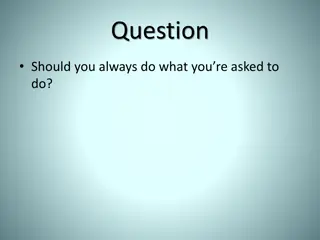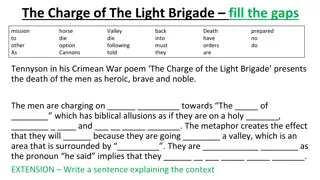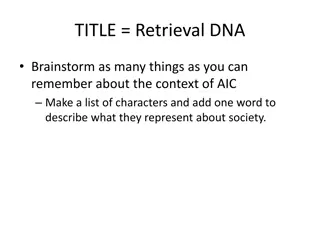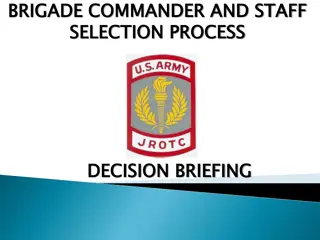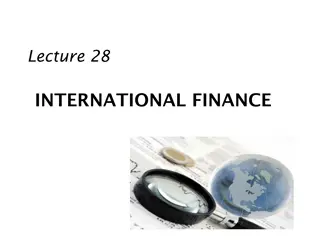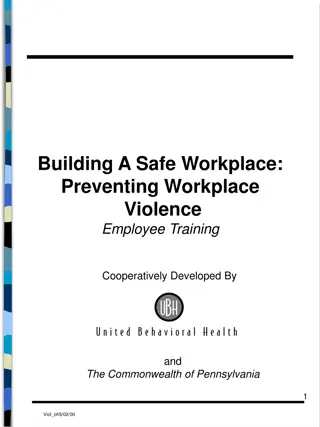Comparative Analysis of Violence in 'Charge of the Light Brigade' and 'Exposure'
Compare how the poets Lord Alfred Tennyson and Wilfred Owen present ideas about violence in their poems 'Charge of the Light Brigade' and 'Exposure' respectively. Tennyson's work glorifies war and sacrifice, while Owen's piece critically reflects on the brutality and futility of conflict. Explore their contrasting use of language, imagery, and themes to convey the impact of violence on individuals in warfare.
Download Presentation

Please find below an Image/Link to download the presentation.
The content on the website is provided AS IS for your information and personal use only. It may not be sold, licensed, or shared on other websites without obtaining consent from the author. Download presentation by click this link. If you encounter any issues during the download, it is possible that the publisher has removed the file from their server.
E N D
Presentation Transcript
Choose 5 poems from the anthology that you have a lot to say about Link them to a theme . Power of Nature Physical Violence Psychological violence Conflict of war Death Loss Patriotism Memory Inner conflict Men Women Conflict in family Violence Themes Poetic devices Ozymandias Exposure Kamikaze War Photographer Poppies
Compare the ways poets present ideas about violence in Charge of the Light Brigade and one other poem from Power and Conflict Charge of the Light Brigade Themes & Context Victorian Glorifying War (though subliminally critical blundered) Exposure Themes and Context WW1 Tedium and relentless violence of war Language The monotone and focus on weather. Use of bathos and understatement For love of God seems dying Imagery of death is quiet linked to nature all their eyes are ice Language Use of repetition and anaphora to create a sense of glory but also exaggerate the sacrifice made Imagery of death is loud jaws of death and mouth of Hell
Structuring a comparative response 1. Comparative introduction - compare themes and context and answer the question 2. Comparative PETAL x 2 with a strong focus on language In Charge of the Light Brigade, Tennyson uses . Whereas in in Exposure . 3. Evaluative conclusion
Compare the ways poets present ideas about violence in Charge of the Light Brigade and one other poem from Power and Conflict Charge of the Light Brigade was written by the Poet Laureate Lord Alfred Tennyson to commemorate the deaths of 600 soldiers in the Crimean War. The Charge of the Light Brigade had been criticised in the press at the time but Tennyson s public position would have meant that he needed to celebrate and support national foreign policy. Thus, although it is possible to find some criticism of the charge contained within the poem ( blunder d ), on the whole, the poem seems to celebrate the violence and might of the six hundred . In contrast, Owen s poem, Exposure is an unashamedly angry and bitter piece about the waste of life in war. Interestingly in this poem,
Comparative PETAL The violence of the Charge is presented through thunderous repetition and onomatopoeia: Cannon to right of them, Cannon to left of them, Cannon in front of them Volley dand thundered The combined use of anaphora and epistrophe in the first three lines reflects the entrapment of the soldiers while the enjambement into the onomatopoeic sounds of the fourth lines has the readers, like the soldiers literally lurching into the deafening blasts of cannon fire. Here, violence is represented as grandiose and exaggerated through the rolling rhythms and anaphora it is both terrifying and glorious. In stark contrast then, is the quiet, insidious violence of Owen s twitching agonies and poignant misery . Owen uses understated fricatives: the flickering gunnery rumbles far off, like a dull rumour and quieter onomatopoeia with the word rumble which is echoed in the assonant Rumour . No crashing or glory for these soldiers the violence inflicted on them is described as stealth[y] and fingering. The violence in Owen s poem is personified as secretive and quiet, but no less deadly


